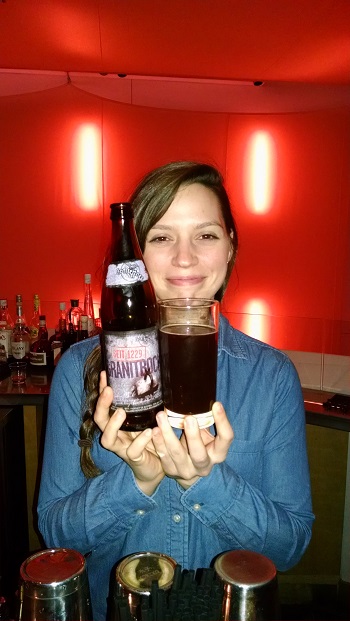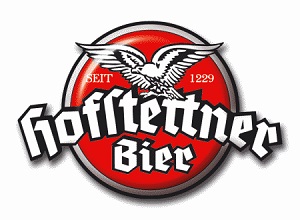Line In The Snow

Brewery and Country of Origin: Brauerei Hofstetten Krammer GmbH & Co. KG of Adsdorf 5, 4113 Sankt Martin/MUhlkreis, Austria
Date Reviewed: 2-10-15
Yesterday, the city of Boston received an additional 21" of accumulating snow, on top of the 5" it received Sunday, and the record breaking 47" it received in the two previous storms over the last two weeks. And because temperatures have been very cold, the snow hasn't had any chance to melt. With the upcoming week's highs expected to remain south of 24 degrees, it doesn't look like the snow, which has already forced Boston's new mayor, Marty Walsh, to increase the snow removal budget after only two snow storms, is going away any time soon. In some areas, especially more the urban Boston neighborhoods of Dorchester, Brighton, Southie, and Allston, the snow banks are well above 7 feet tall. And even with a ballooning snow removal budget, most of the side streets with these massive piles won't see a front loader or a dump truck all season. And perhaps the only thing that's growing more than the piles and the expense, are the tensions neighbors are routinely dealing with when it comes to parking. For those of you not from the Boston area, driving is a form of comedy. On the highways, there are only two driving speeds: those doing 90 on I-90, and those doing about 40 mph less on the same road, and this effective turns the highways into massive looms with no thread. Massachusetts, and especially Beantown, is notorious for its high frequency road rage and careless driving. And this is interesting, because much of the Boston area doesn't move fast enough to cause major accidents, since most of the roads are overloaded parking lots built upon vague routes formed by old cow paths with no sense of logic or reason. This creates problems, not only for the unsuspecting tourist or the directionally challenged, but also for the snow removal efforts. If the roads are barely wide enough for cars to not only park on the side, but also drive through without incident, heavy snow removal equipment has no chance of doing its job without either writing off every car on the block, or forcing every Boston resident to pay for parking. Both of which are definitely not happening. So what is the alternative? Well, historically, it's been to encourage everyone to take public transport, but the only thing more out of date than Boston's roads, is its mass transport. While the Green Line is a trolley which is suspect to the routine breakdown and traffic accident, both the Red Line and the Orange Line have also proven that a bit of frozen water can stop a city which, over a few hundred years, should have grown accustomed to it. But it hasn't, so much of the city's commuters drive to work, and that means parking trouble. In non snow-emergency routes, the snow ends up along the side of the roads, where people usually park their cars. This means that one must first use a shovel and a bit of manual labor to dig their car out before they extricate it from the side of the road, and subsequently go along their merry way.
But for some, the act of moving a bit of powdery water from one place to another five feet away, is simply too much to bear. Ergo, many residents resort to using space savers. Space savers are trash, furniture, traffic cones, and other nonsense placed in the middle of a public road for the purpose of preventing other road users from parking in the spot they shoveled out. As you would imagine, this has spurred on the annual heated debate about whether residents should be able to save spaces or not. Personally, we categorically detest the idea of saving a publicly funded piece of the road for one's own private use. Everyone has to shovel out their cars, everyone pays taxes to build and maintain the roads, everyone has to search near and far to find an adequate parking space. No one would use a space saver in the summer, during which time, if you can't find a spot, you circle the block and gradually expand your search to other roads until you can park your car. But when the ground turns white, people suddenly feel entitled to clear off their windshield by brushing the snow into traffic, shovel the now around their car into the road, and proceed to drive away with their former parking location held within the confines of their own possession by some litter, much in the same way a dog marks its territory (and a mountain of snow on the top of their car, which ends up on everyone else). Of course, not everyone agrees with this policy. Many have the "audacity" to get out of their cars, move the obstruction, and park their cars in "someone else's" beloved parking spot, in spite of the risk of retribution. And this division in philosophy will usually lead to neighbors fighting over a mere space. Insurance companies receive calls from car owners who claim neighbors have slashed their tires or keyed their cars in response to what they'd consider to be grand larceny. And part of the problem is what Marty Walsh said after the first major storm a couple of weeks ago. Whilst giving a press conference on the storm prep for Boston, Mayor Walsh was asked if people were allowed to save spaces they've shoveled out. Rather than making a blanket, simplified rule of "not allowed," he kept to the tradition of "you have 48 hours after a snow emergency has been declared." While this is the law, that also doesn't prevent people from moving or destroying the obstructions, either. And some people on both sides resort to letters, stating their opinions as to why its wrong to either save a space, or remove someone's space saver, place them on the space occupying garbage or car respectively.
This practice is also commonplace in Baltimore, Pittsburgh, and formerly, Washington, D.C., which has outlawed space savers. It doesn't look like it's going away in Boston any time soon, however. So for now, we must all deal with the yearly tradition of neighbors hating each other and cars getting vandalized, because as long as the practice is enabled by the law, there are going to be differing viewpoints. Once the law is changed, the practice will eventually die out altogether because the city will be able to issue tickets, which means more revenue for the coffers. All of this stems from the fundamental fact that shoveling snow is looked at as a monumental feat. People claim that because they've shoveled out their car, they've put sweat equity into a road. The reason people die shoveling snow after each major Nor'easter, isn't because of the evils of frozen water. It's the fact that moving the snow is likely the only physical activity that person has completed in a year, and that, combined with cold air, puts a major strain on their cardiovascular system, respiratory system, muscular system, and skeletal system, especially the arms, shoulders, and back. And as expected, it is a heart attack that eventually creates the headlines. Shoveling out a spot does not entitle you to that spot. Your "unfortunate" situation is not one of singularity. In fact, the majority of your neighbors deal with the same manual labor, the same cold feet, the same sore arms, and the same long commute. Quit your bitchin' and deal with the sole fact that you chose to live in a wintery part of the world, work at a place with no public transportation, and neglect to acknowledge the existence of exercise. Ah yes, and here we have a Doppelbock from Austria.
Date Sampled: 11-29-14 At: Ma Peche, Chambers New York Hotel, Midtown, 15 West 56th Street, Manhattan, New York, NY 10019, USA
Beer Style: Doppelbock
Alcohol by Volume: 7.30%
Serving Type: 500 ml Bottle, 12 oz Stange Glass
Rating: 3.84
 Granitbock Doppelbock
Granitbock Doppelbock



